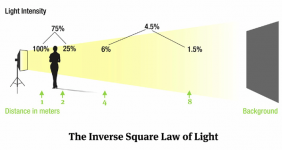...with a row of street lights, it is the nearest 3 or 4 that do most of the useful lighting.
You are obviously looking at this from the point of view of a pedestrian (see attachment).
However, calculations on street lighting appear to meet the needs of the motorist, who is moving along the road, rather than those of the pedestrian, who is pretty much stationary by comparison.
The calculations ensure:
1. Proper illuminance level E, in lux, of road and surroundings (5m away from the road on both sides will be lit by illuminance level at least 50% of that on the road), and,
2. Uniformity of Illuminance U, the ratio of minimum illuminance level to maximum illluminance level, as the motorist proceeds along the road.
https://www.electrical4u.com/road-lighting-design/
Modern dazzling bluish LED car headlights are a thoroughly bad idea too.
I thoroughly agree, so much so that I now try to avoid driving at night because of the glare they cause in my ageing eyes (except where adequate street lighting is installed that is!).
EDIT: I had to change what I wrote in the U ratio segment to Emin/Emax - different sources seem to define this in different ways!
Attachments
Last edited:
"thoroughly agree"? That's it??? Why don't you 'smartish' math guys come up with a remote we can point and turn the f#$%^&g things off!!! Lots of these idiots aren't content with just the mains, they need their fog/driving lights on too...in the city with lighting so you can't even tell if your own headlights are on or not! Lots even have their high beams on.You are obviously looking at this from the point of view of a pedestrian (see attachment).
However, calculations on street lighting appear to meet the needs of the motorist, who is moving along the road, rather than those of the pedestrian, who is pretty much stationary by comparison.
The calculations ensure:
1. Proper illuminance level E, in lux, of road and surroundings (5m away from the road on both sides will be lit by illuminance level at least 50% of that on the road), and,
2. Uniformity of Illuminance U, the ratio of minimum illuminance level to maximum illluminance level, as the motorist proceeds along the road.
View attachment 1104346
https://www.electrical4u.com/road-lighting-design/
I thoroughly agree, so much so that I now try to avoid driving at night because of the glare they cause in my ageing eyes (except where adequate street lighting is installed that is!).
EDIT: I had to change what I wrote in the U ratio segment to Emin/Emax - different sources seem to define this in different ways!
where's my hammer
where's my hammer
Where's your capital letter and question mark? You see, I'm 'smartish' at English too! 😛
P.S. I agree with your sentiments.
P.P.S. See attachment...
Attachments
I'm assuming a mostly homogenous density of mass throughout most galaxies.
I'm also assuming spiral galaxies are rotating at fairly impressive speeds.
So are the bent arms evidence of time dilation,- falling back and curving the visible arms, due to travelling at greater speeds relative to their galaxy's core?
Do the amorphous globular clusters rotate at a much slower speed, if at all?
I'm also assuming spiral galaxies are rotating at fairly impressive speeds.
So are the bent arms evidence of time dilation,- falling back and curving the visible arms, due to travelling at greater speeds relative to their galaxy's core?
Do the amorphous globular clusters rotate at a much slower speed, if at all?
It is funny that we were recently talking about the Vera. C. Rubin telescope, now under construction. Essentially a rapid sky survey instrument:
https://en.wikipedia.org/wiki/Vera_C._Rubin_Observatory
Vera Rubin first identified dark matter as an explanation of discrepancies in galactic rotation:
https://en.wikipedia.org/wiki/Vera_Rubin
https://en.wikipedia.org/wiki/Galaxy_rotation_curve
It's amazing how many experiments are being done right now. Here's one that looks to minor subtleties in General Relativity:
https://en.wikipedia.org/wiki/Gravity_Probe_B
Gravitoelectromagnetism and frame-dragging? All deeply baffling. I think you'd need considerable college study of General Relativity and other things to even get a grip on the problem. I know I don't understand much of it. I'll leave it to the brainier experimentalists to untangle. 😕
https://en.wikipedia.org/wiki/Vera_C._Rubin_Observatory
Vera Rubin first identified dark matter as an explanation of discrepancies in galactic rotation:
https://en.wikipedia.org/wiki/Vera_Rubin
https://en.wikipedia.org/wiki/Galaxy_rotation_curve
It's amazing how many experiments are being done right now. Here's one that looks to minor subtleties in General Relativity:
https://en.wikipedia.org/wiki/Gravity_Probe_B
Gravitoelectromagnetism and frame-dragging? All deeply baffling. I think you'd need considerable college study of General Relativity and other things to even get a grip on the problem. I know I don't understand much of it. I'll leave it to the brainier experimentalists to untangle. 😕
The Clocks went back an hour last night, so am a bit discombobulated this morning....
I checked a few speeds in the solar system and galaxy. Between 20 miles/second and 70 miles per second for most things planetary and galactic.
https://www.space.com/33527-how-fast-is-earth-moving.html
This is nothing compared to the speed of light at 186,000 miles/second. I think we can discount time dilation in special relativity as being significant.
Even Mercury experiences only the tiniest of General Relativity effects on its orbit. The precession of its perihelion, which is detectable.
Our Galaxy rotates once every 230 Million years.
I'd say that is very slow indeed. 😎
I checked a few speeds in the solar system and galaxy. Between 20 miles/second and 70 miles per second for most things planetary and galactic.
https://www.space.com/33527-how-fast-is-earth-moving.html
This is nothing compared to the speed of light at 186,000 miles/second. I think we can discount time dilation in special relativity as being significant.
Even Mercury experiences only the tiniest of General Relativity effects on its orbit. The precession of its perihelion, which is detectable.
Our Galaxy rotates once every 230 Million years.
I'd say that is very slow indeed. 😎
;-)
"Universe" does not expand! Universe is a concept, not a thing.
And, as example: The redshift of the light from quasars is a misinterpretation based on a misobservation. Quasars are bound to galaxies, losing their strong redshift with age and distance.
"Universe" does not expand! Universe is a concept, not a thing.
And, as example: The redshift of the light from quasars is a misinterpretation based on a misobservation. Quasars are bound to galaxies, losing their strong redshift with age and distance.
Welcome, cumbb.
Are you referring to the controversial ideas of astronomer Halton Arp which are not in accord with our standard model of cosmology?
Are you referring to the controversial ideas of astronomer Halton Arp which are not in accord with our standard model of cosmology?
I rarely even, very rarely.... click on any post of such lengths, because I know they contains endless babbling and debating that bores the death out of me.
Many posts have a very poor signal to noise ratio. It makes it hard to follow a topic.
This is just a trend on the internet in general. Bickering and woo dilute any worthwhile conversation. There has to be a name for this phenomenon.
This particular topic is very interesting to me and the only thing I can say to this question is "I don't know." I think that time and space are emergent properties of an expanding universe but don't cite me on that. I am completely agnostic on the position and struggle to understand what I suspect nobody really understands.
Speaking of woo, it looks like we might be crossing into flat earth territory. Ironic after discussing relativity and cosmology but it does prove my point.
Our Galaxy rotates once every 230 Million years.
That means the Milky Way has only rotated a few dozen times! 😎
I've been finding out more about differential rotation:
Points more distant from the centre of rotation of a solid disc will move at greater speeds than those closer in, but regions that are next to each other at any point in time will remain next to each other as the disc rotates.
However, the Milky Way is not a solid disc! Regions that are next to each other at one point in time do not necessarily remain next to each other - this is called differential rotation.
All objects in the disc of the Milky Way galaxy are actually moving at roughly the same speed. However, the outer stars have further to travel in their orbit around the galactic centre and therefore lag behind the inner stars, forming the spiral pattern.
Of course, discrepancies have been found where the outer stars in certain spiral galaxies are moving at a greater speed than the inner stars. The solution to that conundrum is to hypothesise the existence of a dark matter halo surrounding the galaxy - See Steve's references on post # 10.826 regarding Vera C. Rubin and the Galaxy Rotation Curve.
Bickering and woo dilute any worthwhile conversation.
We strive to keep bickering to a minimum in this thread. 👍
In Science we don't Philosophise or Opinionate. Unlike a lot of other more disreputable subjects frequently discussed in bars... LOL.
https://bigthink.com/starts-with-a-...arrassed-to-ask-about-the-expanding-universe/
It is all a consequence of Einstein's General Relativity equations, AFAIK.
Most of the Quantum Stuff pops up when you add Special Relativity to the, say, Dirac Equation for electrons. You get SPIN and ANTI-MATTER!
https://cerncourier.com/
Endless Particle Physics fun there and quite the leading edge. Hope it helps.

BTW, this bit of orbital mechanics is just to add visual appeal to my post. But interesting I think. The Reduced Mass solution going beyond Kepler.
😀
5 questions you were too embarrassed to ask about the expanding Universe
https://bigthink.com/starts-with-a-...arrassed-to-ask-about-the-expanding-universe/
It is all a consequence of Einstein's General Relativity equations, AFAIK.
Most of the Quantum Stuff pops up when you add Special Relativity to the, say, Dirac Equation for electrons. You get SPIN and ANTI-MATTER!
https://cerncourier.com/
Endless Particle Physics fun there and quite the leading edge. Hope it helps.
BTW, this bit of orbital mechanics is just to add visual appeal to my post. But interesting I think. The Reduced Mass solution going beyond Kepler.
😀
`Oh really? If "Mathematics is not 'ripe' enough for such questions", how do you propose to answer the more ardent one, was mathematics invented or was it discovered?In Science we don't Philosophise or Opinionate. Unlike a lot of other more disreputable subjects frequently discussed in bars... LOL.
😀
take your pick. 😊
discombobulated ...The Clocks went back an hour last night, so am a bit discombobulated this morning....
I checked a few speeds in the solar system and galaxy. Between 20 miles/second and 70 miles per second for most things planetary and galactic.
https://www.space.com/33527-how-fast-is-earth-moving.html
This is nothing compared to the speed of light at 186,000 miles/second. I think we can discount time dilation in special relativity as being significant.
Even Mercury experiences only the tiniest of General Relativity effects on its orbit. The precession of its perihelion, which is detectable.
Our Galaxy rotates once every 230 Million years.
I'd say that is very slow indeed. 😎
//
Ethan Siegel furnishes a compact summary of the answers previously given in this thread to questions regarding the expansion of the universe (see Steve's link in post #10,834).
Essential reading for those not well scholared in cosmology. 😎
Essential reading for those not well scholared in cosmology. 😎
5 questions you were too embarrassed to ask about the expanding Universe
https://bigthink.com/starts-with-a-...arrassed-to-ask-about-the-expanding-universe/
Thank you for this. This provides excellent explanations.
"The Universe may be a complicated place, but at least you now know the answers to five of its most commonly misunderstood questions!"
What an understatement. There are a whole lot of misconceptions that are the bedrock of woo.
I'll admit that the meaning of the word "woo" eluded me until I looked it up in the slang dictionary.
"woo = unscientific things that people believe"
"woo = unscientific things that people believe"
- Status
- Not open for further replies.
- Home
- Member Areas
- The Lounge
- What is the Universe expanding into..

